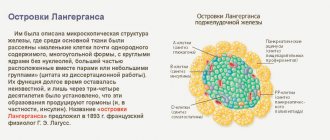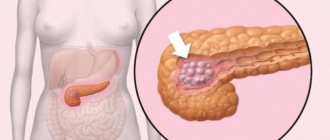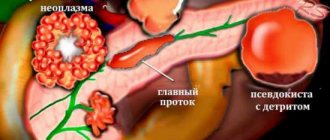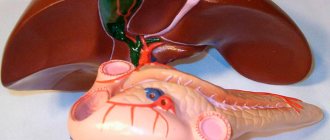The pancreas is an important organ of the human body, performing intrasecretory and exocrine functions. The main task of the gland is to secrete pancreatic juice, which contains a large amount of digestive enzymes. If the pancreas works abnormally, its functionality is impaired, as is the volume and composition of the biological fluid secreted. As a result, digestive problems are noted that require timely elimination and restoration of proper functioning of the organ.
Considering that the main task of the pancreas is the production of pancreatic juice, you should carefully consider the materials related to this topic, find out how, in what quantity and where it is secreted, why it is needed and what its composition is. This will allow you to fully appreciate the importance of the gland and understand why everything should be done to maintain its healthy functioning.
Pancreatic juice is a fluid produced by the gland that ensures normal digestion. At least 1.5 liters and no more than 2 liters should be produced per day, and its production is controlled by the endocrine and nervous system. If less fluid is released, the person’s food absorption process is disrupted, and therefore he will consume a lot of food, while losing weight. If, on the contrary, more fluid is released, this will lead to the development of acute and chronic pancreatitis.
Interesting : as a rule, most women strictly monitor their weight. Wanting to lose weight, they begin to take a variety of medications. Often people, losing weight at a high speed, while eating a lot of food, believe that it is special weight loss products that contribute to such weight loss, ignoring this fact, which can cause the development of pathology.
The pancreas produces two groups of specific substances (enzymes)
One group is digestive enzymes. They are removed from the gland through ducts into the intestines.
The second group is released directly into the blood. These are substances necessary for the regulation of metabolic processes throughout the body.
The release of substances into the intestines is called exocrine pancreas or its exocrine function.
The release of secretion into the blood is an internal secretion or intrasecretory function of the pancreas.
But today we will only touch on its role in digestion. That is, its exocrine activity.
Traveling through the human digestive tract, we visited the duodenum. And there we encountered an abundance of digestive enzymes, which, as we learned, enter the intestines from the pancreas.
Location of the organ
The pancreas is a rather voluminous organ, which is located in the center of our body, localized under the stomach. Under it there are solid vessels, and then the spine is located. Looking at your stomach, the gland is dislocated in its upper part, the retroperitoneal area.
Positioned almost horizontally, it rests under the left rib with its tail, which has the smallest width - up to 0.5 cm. The second large part of the organ is called the head. The width of this part reaches up to 7.5 cm. The head moves into the part of the gland called the body, up to 5 cm in width. The entire organ has a length of up to 23 cm.
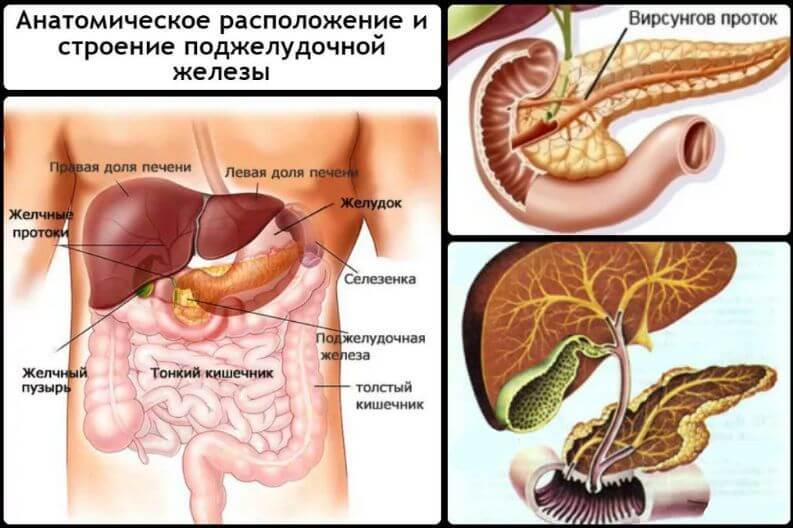
The initial section of the small intestine in humans, called the duodenum, tightly covers the head. The main duct of the gland, called the Wirsung, opens into its cavity, releasing pancreatic enzymes. They help break down food into molecules that are absorbed into the blood and nourish our body. The terminal part of the Wirsung duct unites with the duct through which bile moves. Therefore, the digestive function is performed by 2 organs: the liver and the pancreas.
What pancreas?
In order to answer this question, we need to deviate somewhat from our course. Because the pancreas is located slightly to the left of the duodenum.
The human pancreas is a conical organ, 14 to 22 cm long and 3 to 9 cm wide. Its weight is only 70-80 g!
It is located across the abdominal cavity in its upper part.
Consists of three parts:
- heads
- body
- tail
Pay attention to how close the gland is to the duodenum. The intestine literally envelops the head of the gland.
The pancreas, unlike the stomach and intestines, is a parenchymal organ and not hollow. This means that it all consists of tissue, and there is no cavity in it, as we see in the example of the stomach, intestines or gall bladder.
Gland tissue is a collection of small cells that ensure the production of digestive juice.
Structure and functions of the pancreas
The pancreas in the digestive system is the second most important and largest organ after the liver, which is assigned two important functions.
Firstly, it produces two main hormones, without which carbohydrate metabolism will be unregulated - glucagon and insulin. This is the so-called endocrine or endocrine function of the gland.
Secondly, the pancreas promotes the digestion of all food products that enter the duodenum, i.e. is an exocrine organ with excretory functionality.
The gland produces juice containing proteins, trace elements, electrolytes and bicarbonates. When food enters the duodenum, juice also enters there, which, with its amylases, lipases and proteases, so-called pancreatic enzymes, breaks down food substances and facilitates their absorption by the walls of the small intestine.
The pancreas produces about 4 liters of pancreatic juice per day, which is precisely synchronized with the supply of food to the stomach and duodenum. The complex mechanism of the functioning of the pancreas is ensured by the participation of the adrenal glands, parathyroid and thyroid glands.
Hormones produced by these organs, as well as hormones such as secretin, pancrosin and gastrin, which are the result of the activity of the digestive organs, determine the adaptability of the pancreas to the type of food taken - depending on the components it contains, the gland produces exactly those enzymes that can provide their most efficient splitting.
The structure of the pancreas
The self-explanatory name of this organ indicates its location in the human body, namely: under the stomach. However, anatomically, this postulate will only be valid for a person in a supine position. In a person standing upright, both the stomach and pancreas are approximately at the same level. The structure of the pancreas is clearly reflected in the figure.
The structure of the pancreas
Anatomically, the organ has an elongated shape, somewhat similar to a comma. In medicine, the gland is conventionally divided into three parts:
- A head, no more than 35 mm in size, adjacent to the duodenum, and located at the level of the I – III lumbar vertebra.
- The body is triangular in shape, no more than 25 mm in size and localized near the first lumbar vertebra.
- The tail, with a size not exceeding 30 mm, has a pronounced cone shape.
The total length of the pancreas in normal condition is in the range of 160-230 mm.
Its thickest part is the head. The body and tail gradually taper, ending at the hilum of the spleen. All three parts are combined in a protective capsule - a shell formed by connective tissue.
Localization of the pancreas in the human body
Compared to other organs, the pancreas is located in the most rational way and is located in the abdominal cavity.
Anatomically, the spine runs behind the gland, in front is the stomach, to the right of it, below and above is the duodenum, and to the left is the spleen. The abdominal aorta, lymph nodes and celiac plexus are located in the posterior part of the body of the pancreas. The tail is located to the right of the spleen, near the left kidney and left adrenal gland. The sebaceous bursa separates the gland from the stomach.
The location of the pancreas relative to the stomach and spine explains the fact that in the acute phase, the pain syndrome can be reduced by the patient sitting and leaning slightly forward. The figure clearly shows that with this position of the body, the load on the pancreas is minimal, since the stomach, displaced under the influence of gravity, no longer affects the gland with its mass.
Histological structure of the pancreas
The pancreas has an alveolar-tubular structure, due to two main functions - to produce pancreatic juice and secrete hormones. In this regard, the gland has an endocrine part, approximately 2% of the organ’s mass, and an exocrine part, accounting for about 98%.
The exocrine part is formed by pancreatic acini and a complex system of excretory ducts.
The acini consists of approximately 10 cone-shaped pancreatocytes connected to each other, as well as centroacinar cells (epithelial cells) of the excretory ducts.
Through these ducts, the secretion produced by the gland enters first the intralobular ducts, then the interlobular ducts, and finally, as a result of their fusion, into the main pancreatic duct.
The endocrine part of the pancreas consists of the so-called islets of Langerans, localized in the tail and located between the acini (see figure):
The islets of Langerans are nothing more than a cluster of cells whose diameter is approximately 0.4 mm. In total, iron contains about one million such cells. The islets of Langerans are separated from the acini by a thin layer of connective tissue, and are literally penetrated by myriads of capillaries.
The cells that form the islets of Langerans produce 5 types of hormones, 2 of which, glucagon and insulin, are produced only by the pancreas, and play a key role in regulating metabolic processes.
Source: https://pancrea.ru/function-pancrea-structure.html
What is she doing?
The human pancreas is the main laboratory for the synthesis of digestive enzymes. Those enzymes that break down the food we eat into smaller elements.
In between meals, the pancreas produces a very small amount of juice. But as soon as food enters the duodenum, its intensive work immediately begins. Intensive synthesis of digestive juice begins, which enters the intestine through the main duct of the gland.
Gastroenterologists in Moscow
Gastroenterologists of the Moscow region
Detailed information about each doctor, photo, rating, reviews, quick and convenient appointment.
In just one day, the small gland produces from 1.5 to 2.5 liters of juice of a rather complex composition!
The gland, as I already said, consists of many small cells, which, in fact, produce what we call digestive juice.
These cells are united among themselves into small groups - acini. Each of these cells releases its secretion into a tiny intercellular space. The so-called tubule (see picture).
Just as small streams merge into a large and full-flowing river, so these channels merge with each other, ultimately forming a large canal.
This is the main channel of the pancreas, called the Wirsung duct. This duct flows into the duodenum, carrying juice containing a lot of digestive enzymes.
Pancreatic juice has a slightly alkaline reaction and is rich in enzymes that digest all types of nutrients: proteins, fats, and carbohydrates. Some of these enzymes enter the intestine in an active state, while the other part is inactive and is activated only in the duodenum.
Functions of the gland
The structure of the pancreas provides it with the ability to perform two functions - exocrine and endocrine. This is a very interesting combination, which we will consider in more detail.
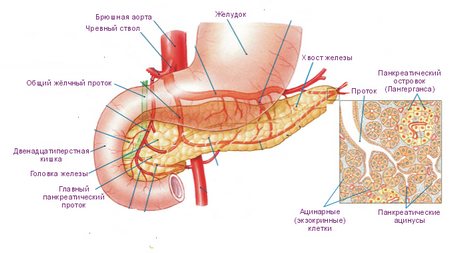
Among the cells that produce digestive enzymes are areas in which hormones are synthesized
Exocrine function
In the lobules of the pancreas there are acini - areas of several cells, some of which (there are about 8-10 in one acini) synthesize enzymes, others are involved in the excretion of the formed pancreatic juice. The ducts between the functional cells merge into the interacinous ducts, which flow into the intralobular ducts, the latter into the interlobular ducts. The interlobular ducts empty into the common large pancreatic duct.
The pancreas synthesizes about 2 liters per day of special pancreatic juice. The main part of this juice is enzymes formed in the acini. This:
- lactase;
- lipase;
- maltase;
- trypsin;
- chymotrypsin
- some others.
Article on the topic: Reactive pancreatitis as a type of inflammation of the pancreas
Each enzyme is designed to break down a specific structure. Thus, lipase breaks down fats into fatty acids, lactase processes milk lactose, and trypsin converts proteins into amino acids. For more detailed information on this issue, we recommend that you read the article on pancreatic enzymes.
This pancreatic juice is secreted in response to food intake. The peak of secretory activity of the gland is observed 1-3 hours after eating; the duration of its work depends on the nature of the food taken (protein breaks down longer). The secretion of pancreatic juice is regulated by hormone-like substances produced in the stomach - pancreozymin, gastrin and secretin.
The most dangerous enzymes that can digest their own tissues (in acute pancreatitis) are trypsin and chymotrypsin. They are secreted into the ducts in the form of inactive substances - proenzymes. Only in the duodenum, when combined with the substance enterokinase, proenzymes are converted into full-fledged enzymes.
Warning! A biopsy of the pancreas is not performed unless absolutely necessary, due to the risk that self-digestion of the tissue may begin.
Regulation of the pancreas
How does the human pancreas “know” that it urgently needs to produce and expel digestive juice? We have already touched on this issue in the previous article.
There are two ways of transmitting information in the human body:
- nerve pathway - using electrical impulses transmitted along nerve endings
- humoral - with the help of special substances transmitted from organ to organ with blood
As soon as food enters the initial part of the duodenum, both types of information transmission are triggered. And the pancreas immediately “knows” that it needs to begin fulfilling its duties.
Now, I think it’s quite clear to you why the human duodenum and pancreas are located so close, so close to each other.
After all, this hardworking couple is the center of our digestion. The pancreas is the main laboratory where digestive enzymes are synthesized. And the duodenum - in the cavity of which these enzymes work, breaking down almost all nutrients.
Intestinal juice
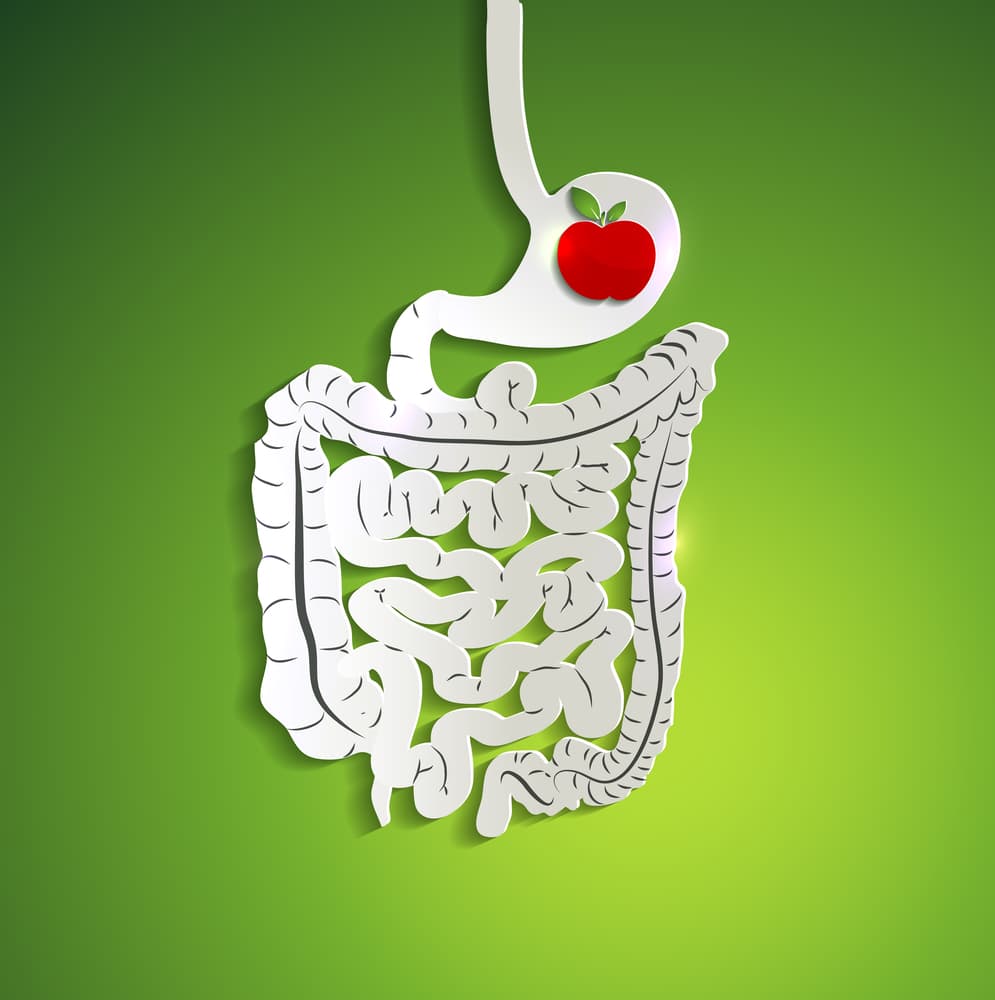
As you know, the pancreas produces intestinal juice, which acts
for food in several stages. The first stage is cavity digestion, the second is parietal, and the third is absorption. In its composition, intestinal juice is a liquid, which consists of the secretion of glands located throughout the small intestine, as well as the dense part. In other words, intestinal juice is a secretion secreted by the glands of different parts of the intestine. Approximately 2.5 liters of this liquid are released in the human body per day.
The main function of intestinal juice is to digest food. Due to cavity digestion, which is carried out by enzymes of two types of fluid: pancreatic and intestinal, large molecular nutrients are hydrolyzed. Cavitary digestion breaks down no more than 10-20 percent of proteins, fats and carbohydrates. Next, parietal digestion occurs, and the final stage is absorption, as a result of which the monomers that were formed in the second stage pass into the lymph and blood.
We figured out what pancreatic and intestinal juice are. Now let’s consider the question: where does the pancreas secrete digestive juice?
? So, the pancreas secretes digestive juices into the digestive tract after food enters the stomach. Thus, food entering the digestive system begins to be processed in several stages. There are three types of juices: pancreatic, gastric, intestinal. In total, the human body produces approximately 8 liters of digestive juices per day.
In order for the body to produce a normal amount of fluid that digests food, it is necessary to adhere to proper nutrition and also pay great attention to food hygiene. Thus, in order to ensure the timely secretion of juices by the organs, it is necessary to adhere to a certain schedule of food intake, which in turn should be tasty prepared and beautifully presented, which significantly enhances the secretion of juices. The food temperature should be optimal, approximately 50-60 degrees, to avoid irritation of the mucous membranes. It is also important to monitor the quality of products so as not to provoke inflammatory processes due to poisoning. These recommendations play an important role in the overall healthy functioning of the digestive system, so each person should appreciate their responsibility for their own health and adhere to the advice given.
Important! Personal hygiene and product quality directly affect the functioning of the digestive system, violation of which can lead to undesirable consequences and serious diseases.
Pancreas: role in the body

Under the influence of hydrochloric acid, the intestines and stomach will begin to collapse. If the pancreas does not perform its function, the organ itself is digested. It has a close relationship with the thyroid gland, so the most common complications are of a secretory nature, for example, diabetes mellitus.
Pancreatic dysfunction, when the gland becomes inflamed, turns into pancreatitis - an equally dangerous disease, the treatment of which is based on medication, surgery and folk treatment.
Treatment
Treating the pancreas at home is strictly prohibited. At the first signs of illness, you should consult a doctor or call an ambulance at home, followed by hospitalization. In this case, medications or procedures may be prescribed depending on the stage of development of the disease.
Many complex destructive pathologies are the result of lack of treatment or improper therapy of pancreatitis. If they are present, if conservative treatment does not produce results, surgery may be prescribed. Within reasonable limits and with the recommendation of the attending physician, traditional medicine can also be used.
